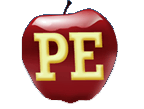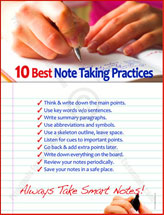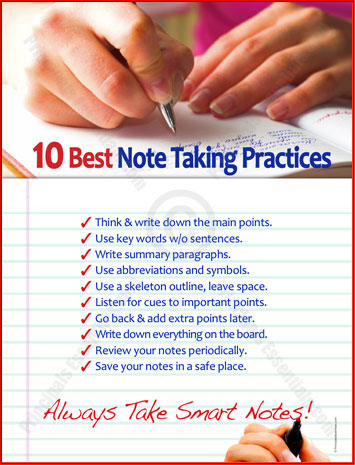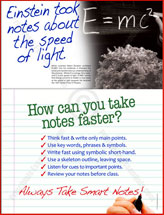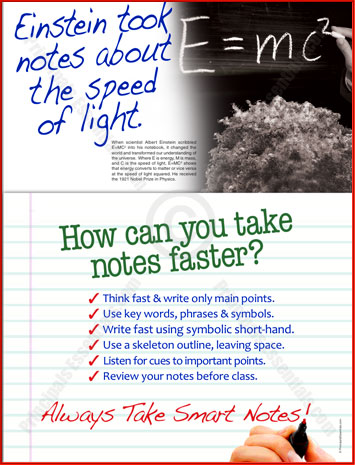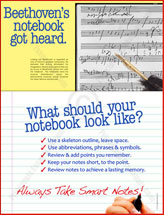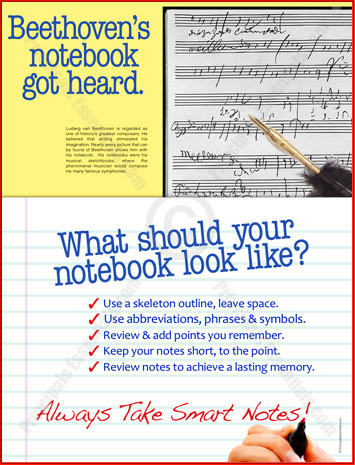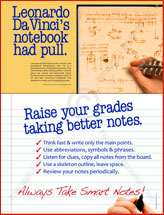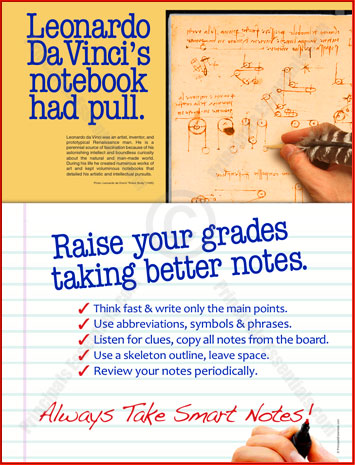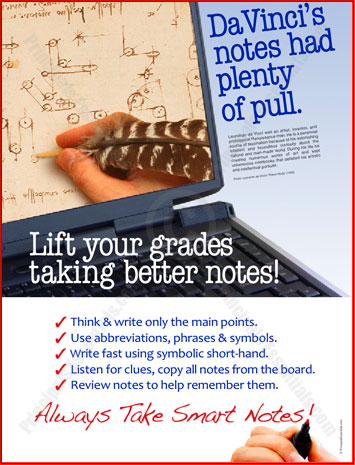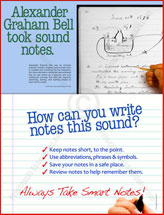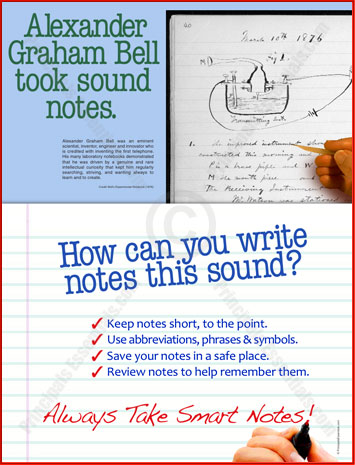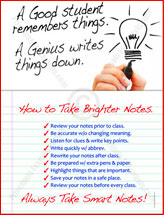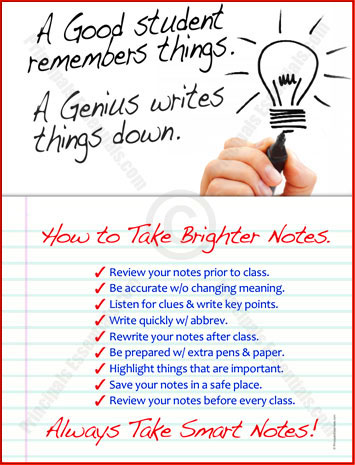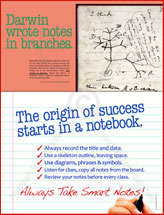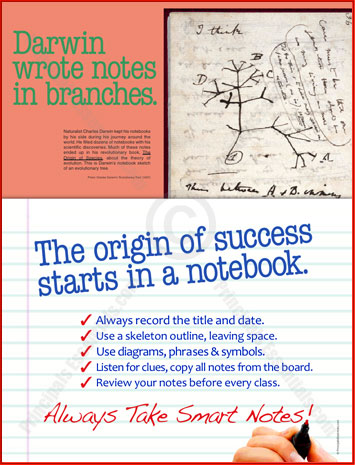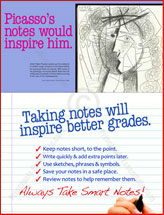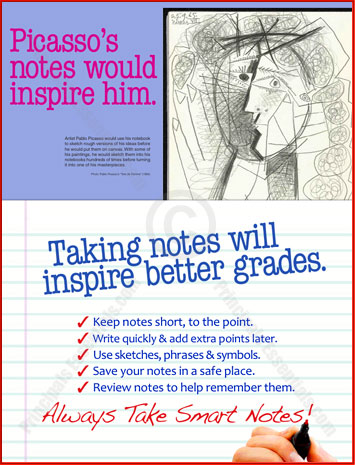• Listen & write down the main points.
• Use key words, phrases & symbols.
• Keep notes short, to the point.
• Use a skeleton outline, leaving space.
• Review your notes before every class.
Ludwig van Beethoven is widely regarded as one of history's greatest composers. He believed that writing stimulated his imagination. Nearly every picture that can be found of Beethoven shows him with his notebook. His notebooks were his musical sketchbooks, where the phenomenal musician would compose the beginnings of many famous symphonies.
10 Best Note Taking Practices Item #J11
• Think & write down the main points.
• Use key words w/o sentences.
• Write summary paragraphs.
• Use abbreviations and symbols.
• Use a skeleton outline, leave space.
• Listen for cues to important points.
• Go back & add extra points later.
• Write down everything on the board.
• Review your notes periodically.
• Save your notes in a safe place.
Einstein took notes about the speed of light.
How can you take notes faster? Item #J12
• Think fast & write only main points.
• Use key words, phrases & symbols.
• Write fast using symbolic short-hand.
• Use a skeleton outline, leave space.
• Listen for clues to important points.
• Review your notes before class.
Always Take Smart Notes
When Albert Einstein scribbled E=MC2 into his notebook, it changed the world and transformed our understanding of the universe. Where E is energy, M is mass, and C is the speed of light, E=MC2 shows that energy converts to matter or vici versa at the speed of light squared. He received the 1921 Nobel Prize in Physics.
• Use a skeleton outline, leave space.
• Use abbreviations, phrases & symbols.
• Review & add points you remember.
• Keep notes short, to the point.
• Review notes to achieve a lasting memory.
Ludwig van Beethoven is widely regarded as one of history's greatest composers. He believed that writing stimulated his imagination. Nearly every picture that can be found of Beethoven shows him with his notebook. His notebooks were his musical sketchbooks, where the phenomenal musician would compose the beginnings of many famous symphonies.
• Think fast & write only the main points.
• Use abbreviations, symbols & phrases
• Listen for clues, copy all notes from the board.
• Use a skeleton outline, leave space.
• Review your notes periodically.
Leonardo da Vinci was an artist, inventor, and prototypical Renaissance man. He is a perennial source of fascination because of his astonishing intellect and boundless curiosity about the natural and man-made world. During his life he created numerous works of art and kept voluminous notebooks that detailed his artistic and intellectual pursuits.
• Think & write only all the main points.
• Use abbreviations, phrases & symbols.
• Write fast using symbolic short-hand.
• Listen for clues, copy all notes from the board.
• Review your notes to help remember them.
Leonardo da Vinci was an artist, inventor, and prototypical Renaissance man. He is a perennial source of fascination because of his astonishing intellect and boundless curiosity about the natural and man-made world. During his life he created numerous works of art and kept voluminous notebooks that detailed his artistic and intellectual pursuits.
• Keep notes short & to the point.
• Use abbreviations, phrases & symbols.
• Save your notes in a safe place.
• Review notes to help remember them.
Alexander Graham Bell was an eminent scientist, inventor, engineer and innovator who is credited with inventing the first telephone. His many laboratory notebooks demonstrated that he was driven by a genuine and rare intellectual curiosity that kept him regularly searching, striving, and wanting always to learn and to create.
• Keep notes short, to the point.
• Use sketches, phrases & symbols.
• Listen for clues & write key points.
• Write quickly w/ abbrev.
• Rewrite your notes after class.
• Be prepared w/ extra pens/paper.
• Always record the title and date.
• Highlight things that are important.
• Save your notes in a safe place.
• Review notes to help remember.
• Always record the title and date.
• Use a skeleton outline, leaving space.
• Use diagrams, phrases & symbols
• Listen for clues, copy all notes from the board.
• Review your notes before every class.
Naturalist Charles Darwin kept his notebooks by his side during his journey around the world. He filled dozens of notebooks with his scientific discoveries. Much of these notes ended up in his revolutionary book, The Origin of Species, about the theory of evolution. This is Darwin's notebook sketch of an evolutionary tree.
• Keep notes short, to the point.
• Write quickly & add extra points later.
• Use sketches, phrases & symbols
• Save your notes in a safe place.
• Review your notes before every class.
Artist Pablo Picasso would use his notebook to sketch rough versions of his ideas before he would put them on canvas. With some of his paintings, he would sketch them into his notebooks hundreds of times before turning it into one of his masterpieces.
Take Notes Like a Master.
Proper note taking plays a key role in a student's academic success. It is clear from our history that note taking has always been an important part of the learning process. Alexander Graham Bell, Ludwig Van Beethoven and Leonardo DaVinci were all devoted to their notebooks. Unfortunately, not all students learn the noteworthy skills necessary to take effective notes. These posters are designed to improve your students' note taking skills and grades, while they learn more with less effort.
Most teachers assume that someone else must have already taught their students how to take and study proper notes. Taking notes is one of those skills that rarely gets addressed in schools. Not only does good note taking help us recall facts we may have forgotten, the act of writing things down and reviewing them later, helps many of us to remember them longer. In fact, writing and studying effective notes can result in higher student test scores.
Only 10% of a lesson may last in a student's memory, but students who take and review notes can recall 80% of a lesson. Despite this benefit, only 65% of all students take notes during class. One reason students may have trouble writing notes is that they're not sure how to write effective notes. Many students attempt to capture an entire record of a class or lesson in their notes, word for word. This can be very frustrating for students who can't keep up with the class and are more likely to drop out. Trying to write down every word and fact leaves no room for thinking about what you're really learning about and how to better recall it. Studies on memory have shown that without review, 47% of what a person has just learned is forgotten in the first twenty minutes and 62% is forgotten after the first day. Therefore, having good lecture notes to review can determine how well a student is able to perform on exams.
Although computers are rapidly becoming more acceptable and represents the future of note-taking, it is receiving mixed reviews by many schools. Some welcome the technology as a learning aid, while others reject it because it is a distraction. Your institution may have a no technology policy. If your district allows computers in classrooms, we recommend having a school policy governing their use to avoid student distractions. Let's start with some basic recommendations. 1) Mute all computers. 2) Turn down screen brightness. 3) Turn off wireless. My advice is that you allow computer note-taking only when it's necessary and when it does not get in the way of the learning.
In conclusion, students will always need help in fine-tuning their skills. If we want our students to be successful learners, we need to remind them of the importance of taking effective notes.
3 Note-Taking Methods
1. Outlining: Whether you use numerals, dashes or bullet points, outlining is an effective way to capture the hierarchical relationships between ideas and data. In a history class, you might write the name of an important leader, and under it the key events that he or she was involved in. Outlining is a great way to take notes from books, because the author has usually organized the material in a fairly effective way, and you can go from start to end of a chapter and simply reproduce that structure in your notes.
2.Mind-mapping: For class lectures, a mind-map might be a more appropriate way of keeping track of the relationships between ideas. Here's how it works: in the center of a blank sheet of paper, you write the lecture's main topic. As new sub-topics are introduced, you draw a branch outward from the center and write the sub-topic along the branch. Then each point under that heading gets its own, smaller branch off the main one. When another new sub-topic is mentioned, you draw a new main branch from the center. If a point should go under the first heading but you're on the fourth heading, you can easily just draw it in on the first branch. Likewise, if a point connects to two different ideas, you can connect it to two different branches.
3.The Cornell System: The Cornell method provides a systematic format for condensing and organizing notes. The student divides the paper into two columns: the note-taking column (usually on the right) is twice the size of the questions/key word column (on the left). The student should leave five to seven lines, or about two inches, at the bottom of the page. Notes from a class are written in the note-taking column; notes usually consist of the main ideas of the text or lecture, and long ideas are paraphrased. Long sentences are avoided; symbols or abbreviations are used instead. See more info.
For aFREE COPY of NOTE TAKING TIPS FOR INSTRUCTORS AND STUDENTS,please submit the form below. * Required
All posters are printed on heavy-weight, plastic coated paper.
